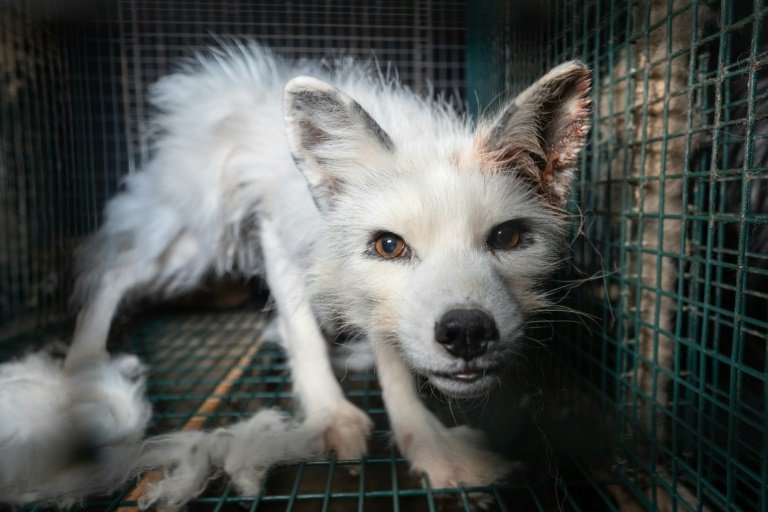Investigation Reveals 'Cannibalism' and Obese Foxes on Fur Farm
Shocking footage of the Finnish fur industry shows huge, deformed foxes sitting in wired cages, as animal advocates call for a ban on the trade.
Credit: Oikeutta Elaimille
A shocking new investigation into Finnish fur farming has thrown the controversial industry into the spotlight again, triggering renewed calls for an EU-wide fur ban.
The footage, released by animal protection groups Oikeutta Elaimille (Justice for Animals) and Humane Society International (HSI), revealed obese, infected, injured foxes confined in small cages and cubs cannibalizing their dead siblings.
Producing nearly one million pelts annually and worth €360 million ($390 million) in exports, the Nordic country is Europe’s biggest fur producer, second in the world only after China.
"Fur farming should have been banned in Finland by now and I think it is shameful that this has not yet been done", Left Alliance MP Mai Kivela told Agence France-Presse (AFP).
Almost 100 percent of Finnish fox fur farms are certified by the fur trade’s SAGA Furs assurance scheme, which promises “the highest level of animal welfare”, according to HSI. Fox fur originating from Finland is used by brands including Fendi, Yves Salomon, Woolrich, Herno, Ermanno Scervino and Max Mara, and is seen in stores including Harrods and Harvey Nichols.
The investigative footage was filmed by Oikeutta Elaimille inside six randomly selected fur farms in the Ostrobothnia region of western Finland between June and November 2022. Four of the farms were confirmed to have been approved by The Finnish Fur Breeders' Association (FIFUR), which certifies farms to ensure animal health.
“The conditions of the animals in these farms are downright appalling,” Kristo Muurimaa of Oikeutta Elaimille told AFP. “There’s rows and rows of animals in small barren wire cages. Many [are] suffering from infected eyes, and other injuries like deformed legs are very common. The animals have been fattened and bred so they grow to a huge size, three or four times their natural size."
Claire Bass, senior director of public affairs at HSI added: “The suffering that millions of animals endure on fur farms, spending their entire lives in tiny barren cages, is heartbreaking. Pus oozing sores, mental breakdown, and cannibalism are the reality of fur farming, and a million miles away from the glossy PR the fur trade tries to sell with its assurance schemes.”
Credit: Oikeutta Elaimille
Boredom is another cruel element of the trade.
“The animals simply don’t have anything to do. They are predators who haven’t really been domesticated,” said Muurimaa. “They’ve been grown in these conditions for less than a hundred years, so they have all of their natural instincts left.”
In response to the footage, FIFUR claims that it does not represent the industry as a whole and condemned the activists as ‘trespassers’.
“They give a completely false picture of fur farming, a one-sided sample,” said Olli-Pekka Nissinen, a spokesman for FIFUR. The association’s veterinarians will reportedly be visiting the accused farms in the coming days.
Muurimaa however, argued that “all Finnish fur farms are more or less the same from an animal point of view.” Finland's animal protection law “is lagging far behind European standards,” he added.
The exposé comes as more than 1.2 million EU citizens have signed the EU-wide “Fur-Free Europe” European Citizens’ Initiative petition calling on the European Commission to ban the farming and sale of fur across the continent.
Multiple European countries, including the UK, France and Italy have already banned fur farming itself, however, the sale of imported fur items is not prohibited.
“The majority of Finns want to ban keeping animals in barren cages just for their fur, but our politicians have failed to bring an end to the cruelty,” said Muurimaa. “An EU-wide ban would help the animals also in other member countries where the greed for money is valued over animal welfare.”
Credit: Oikeutta Elaimille
Many major fashion brands including Gucci, Michael Kors, Burberry, Dolce & Gabbana, and Moncler have removed fur from their collections in favor of more ethical and eco-conscious materials, while the former CEO of the Fur Trade Association has denounced the animal cruelty inherent in the fur trade as “indefensible”.
Despite the progress, around 100 million animals are still killed for their fur every year as part of the global fur trade, including coyotes, minks, raccoon dogs, and chinchillas.
As activists continue to expose and campaign against the trade, fashion brands and designers are turning to next-gen (animal-free, high-performance, and sustainable) materials in place of animal fur. New York City-based material innovation studio and outerwear brand House of Fluff is currently developing BIOFUR, the world’s bio-based and biodegradable animal-free fur. Elsewhere, a new material on the faux fur market is KOBA fur, a bio-based fur made from oil from vegetable crops.
Learn more about next-gen materials with our recent podcast episode with Sydney Gladman and Ranjani Theregowda of Material Innovation Initiative (MII), the non-profit that’s advancing these materials here.
We Have A Favor To Ask…
Species Unite amplifies well-researched solutions to some of the most abusive animal industries operating today.
At this crucial moment, with worldwide momentum for change building, it’s vital we share these animal-free solutions with the world - and we need your help.
We’re a nonprofit, and so to keep sharing these solutions, we’re relying on you - with your support, we can continue our essential work in growing a powerful community of animal advocates this year.
More stories:
Species Unite
A collection of stories of those who fight the good fight on behalf of animals.






Meat giant JBS USA misled consumers with fake sustainability claims to boost sales, the lawsuit alleges.